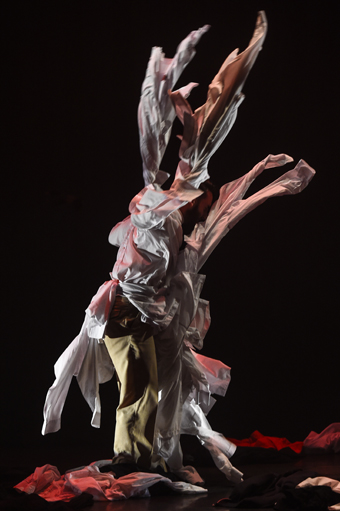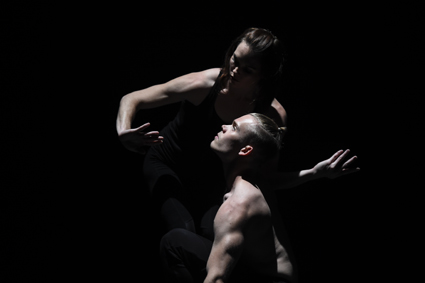Three minds, six bodies, one wonder
Bernadette Ashley: TasDance/Dancenorth,Threefold

Timothy Walsh, In, Gavin Webber, Threefold, photo Leigh Turner, Bottlebrush Studio
Threefold brings together three choreographers, each with a distinctly different aesthetic, for a triple bill of short, powerful, contrasting works. Bosco Shaw’s clever lighting design paradoxically enhances both the delineation of each work and the coherence of the trio of creations, reinforced by the same six mind-blowing dancers performing throughout.
The flow from Huang Yi’s minimalist Echo, focussed on pure gesture, light and shadow, to Gavin Webber’s twitchy acid trip In, to Raewyn Hill’s soul-clutching A dance for the forgotten, is the perfect order for presentation. The audience is prepped by wonderment in the first, raised to fever pitch in the second and have their hearts broken in the third.
A collaboration between Dancenorth and Tasdance, Threefold comprises a suite of two independently commissioned works—Gavin Webber for Dancenorth, Dancenorth’s artistic director Raewyn Hill for Tasdance—and one joint commission by Huang Yi from Taiwan, in his premiere work for an Australian audience.

Echo, Huang Yi
photo Leigh Turner, Bottlebrush Studio
Echo, Huang Yi
Huang Yi, Echo
Echo played out with unnerving precision to a soundtrack of low, incessant industrial rumble. Confined in intermittent squares or spots of bright light, with no discernible beat or phrases to work to, astonishingly the dancers seemed to synchronise every gesture to apparently random loud metallic clangs, clunks and booms.
The number of dancers seemed to change as they moved into the light pools with their shadows and were then absorbed back into the surrounding darkness. The lights switched off and on, merged, separated, as did the dancers, variously moving solo, in duo or ensemble; embracing, chasing, counterbalancing, dragging and re-placing each other. Gestures hinted one moment at capoeira, another at flamenco or ballet. This was dance quick, slow motion, sharp, fluid, combative or complicit, but always exquisitely precise. Spoiler alert: hidden technology was the key to perfect synchronicity in the absence of countable rhythm: rather than the dancers reacting to the sounds, the noises were activated externally by smartphone in response to the dancers’ movement.
Gavin Webber, In
Gavin Webber’s In ends with a dancer facing the audience to apologise: “Yeah, shit got out of hand, sorry,” a fitting conclusion to a chaotic journey (somewhere between a romp and a nightmare) through themes of conformism, bullying, manipulation, aggression, peer pressure, escapism and exhibitionism. Webber uses a recurring motif from his works as former artistic director at Dancenorth: clothing—worn, removed, exchanged, folded, piled, dumped from above to engulf and slapped on the floor in rhythm to Hendrix-like wailing guitars. Commencing with five dancers in business suits with one standout in casual exercise gear, there’s trouble from the start as she’s harrassed to change. But even as she conforms, the bar keeps changing as fast as the clothes do. These brittle, posturing and confused people indulge in a relentless, highly physical, sometimes almost violent game of sabotage while vying for their moment in the sun. “I’ve got something to say about current issues,” shouts one as he’s thrown around by another, “but it may not be pretty.” We never hear what it is as she weighs him down with layer upon layer of jackets.
The piece builds to a prolonged red-lit guitar trance party of frantic shaking bodies, and after the increasing sense of alienation reaches its pitch, the final apologetic statement is like being slapped out of it.
Raewyn Hill, Forgotten
Raewyn Hill’s A dance for the forgotten is the compressed essence of a 60-minute work made for the Tasmanian festival Ten Days on the Island in 2007. Like its place of conception, Port Arthur, the work contains layers of history and tragedy which, supported by the moving score (Eden Mulholland’s reworking of Pergolesi’s Marian Vespers), gives its themes a timelessness. The set conspires in suggestive simplicity. The space is atmospherically sidelit by vertical lighting set into tall wings, two at one side of the stage, one on the other. The dancers, clad in Alistair Trung designed costumes which defy period classification, surge from side to side through golden shafts of light on the otherwise black stage, the physical expression of the call and response in the gothic chant. They surge back, but someone is left behind. “Erynne!” they scream, reaching for the lost one, and sobbing breaths punctuate the music again and again.
A characteristic of Hill’s work is her ability to have multiple performers move as a single organism, from which dancers disassociate and reattach without losing a sense of connection. This is used to outstanding effect, evoking our common humanity and shared grief over unspeakable tragedy. A final series of lifts, a succession with each dancer moving the next, is interrupted with a plea to “Get down!” but a dancer’s hands fling back in slow motion, his chest recoiling, and it is over.
The physical and emotional diversity of Threefold must tax the dancers to the limit, but the energy never flagged in the commitment of Dancenorth’s Alice Hinde, Erynne Mulholland and Andrew Searle and Tasdance’s Sarah Fiddaman, Brianna Kell and Timothy Walsh.
TasDance/Dancenorth, Threefold, Dancenorth, Townsville 7-10 Aug and toured to Mackay, Cairns, Launceston and Hobart.
RealTime issue #123 Oct-Nov 2014 pg. 27






